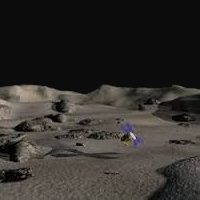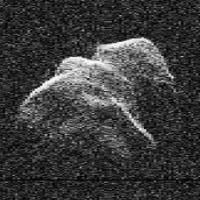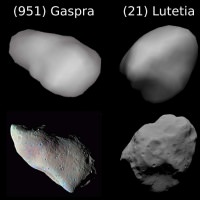What is 3D Asteroid Catalogue?
- 1635 asteroids
- 5 comets
- 2 dwarf planets
- 37 moons
- 3079 models
- 54 textures
- 03 Jul 2021: Updated (101955) Bennu
- 27 Jan 2020: Added (704) Interamnia
- 27 Jan 2020: Added (85990) 1999 JV6
- 01 Nov 2019: Added (486958) Arrokoth
- 01 Nov 2019: Updated (10) Hygiea
- 01 Nov 2019: Updated (16) Psyche
- 01 Nov 2019: Updated (41) Daphne
- 01 Nov 2019: Updated (7) Iris
- 01 Nov 2019: Updated (89) Julia
3D Asteroid Catalogue is an interactive catalogue that contains 3D models, orbital and physical parameters and current orbital position of known minor bodies. There are many scientists working on asteroid research and lots of data available on the Internet, yet I wanted to collect and display this information in a handy way.
3D Asteroid Catalogue shows the following information about asteroids, moons and other minor bodies:
- 3D shape models, derived from lightcurve inversion, radar measurements or spacecraft imagery
- Orbital parameters, like eccentricity and semi-major axis
- Known physical parameters, like size, mass and albedo
- Orbit and its current position in 3D
How it works
The models have been created by scientists, based on a large number of astronomical observations and other data. Basically, there are three methods of deriving a model of a minor body - Spacecraft imaging, Radar Imaging and Lightcurve Inversion.

Spacecrafts provide the best information possible about a minor body but spacecraft missions are very difficult and expensive. Such missions often cost billions of dollars and take years to complete due to huge distances and complexity of orbital mechanics. Still, they provide us with the most detailed information about a space body, including radar and laser altimetry, surface samples and of course images in all kinds of spectra.
A number of objects (433 Eros, 25143 Itokawa, 4 Vesta, 67P/Churyumov-Gerasimenko and more) has been visited by space probes, resulting in a large amount of high-resolution photography and measurements, thus allowing scientists to create very precise models of these objects.
- NEAR Shoemaker article on Wikipedia
- Hayabusa article on Wikipedia
- Rosetta page on ESA
- Cassini mission page on NASA/JPL
- List of minor planets and comets visited by spacecraft on Wikipedia

Radar Imaging is among the most precise methods, but also quite difficult and expensive way of obtaining asteroid shape data. It requres a set of large radio telescopes (with antenna diameter up to 70 meters) working together to obtain "images" of an asteroid from different angles. And the asteroid's position has to be the one that allows the radiotelescope to see it. However, the results are impressive - radar imaging allows to create a surface model of an asteroid with great precision and study its size, shape, rotation state, surface features and to improve the calculation of asteroid's orbit as well.
Most of the radar-based models on this website has been taken from JPL Asteroid RADAR Research page.
- How radio telescopes get "images" of asteroids article by Emily Lakdawalla
- Radar Images of Asteroid Toutatis, NASA/JPL Video
- JPL Asteroid RADAR Research
- Radar Imaging of Near Earth Asteroids, NASA/JPL Video Lecture

From: B. Carry's paper
Lightcurve inversion is another method widely used to derive asteroid's shape, but rarely used for other types of bodies. It is based on a fact that asteroids shine by the reflected sunlight, and since the distance of an asteroid to the Sun and the Earth changes as the asteroid and the Earth orbit the Sun, the brightness of the asteroid changes as well. In addition, asteroids also exhibit brightness variations that are caused by their irregular shape and their rotation. This brightness variation is called a lightcurve. By measuring lightcurves, scientists can measure asteroid's rotation periods and derive a possible shape that would have produced such lightcurves.
Unfortunately, lightcurve inversion technique is not as precise as radar or spacecraft imaging and usually cannot predict all of the asteroid's surface features. In most cases, it can only create a convex shape, while the asteroids are mostly nonconvex. Still, it enables to reveal basic physical characteristics of individual asteroids.
Most of the lightcurve-inversion models on this website has been taken from DAMIT database.
- Asteroids@home distributed project
- Light Curves - Introduction by NASA's Imagine the Universe
- DAMIT database
Where to start
You can start by checking hi-res models of asteroids Eros and Itokawa, watch Ceres and Vesta at close range, view a detailed model of famous comet 67P/Churyumov-Gerasimenko or take a peek on wonderful colored surfaces of Io, Enceladus and Iapetus.
Note that this website uses WebGL to display 3D models, so you must have a WebGL-enabled browser.
